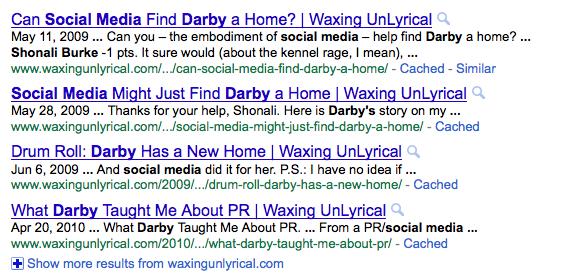 This is part of the Blogging for Grasshoppers series
This is part of the Blogging for Grasshoppers series
[I originally published this post on April 21. This was a post I’d been meaning to write for a long time, because I believe it can really help your blog, so I put a lot of effort into it.
And then, as luck would have it, that was the day of Amazon’s EC2 outage. Which didn’t mean that the blog went down, but Livefyre, the super-duper comment system I’ve been using, did. A lot of people who read the post weren’t able to comment that day. Aargh!
So I decided to republish it today. Maybe I’ll have better luck this time?]
Paying attention
As I’ve been paying more attention to blogging””not just the writing thereof, but the look and how the posts come across””one of the fields that I believe is little-used is the “excerpt” field in one’s WordPress blog.
Of course, this is merely my opinion, but having seen a number of blogs that don’t seem to do this, I thought it time to tell the rest of you grasshoppers why this is important.
Image: Steve Hoang via Flickr, CC 2.0
And also because I promised Ingrid Abboud I would do so, though I would not call her a grasshopper by any stretch of the imagination.
But let’s back up a bit.
The first thing we learn, when we start blogging, is that it’s important to use a plugin such as the All in One SEO Pack, to get our blogs all gussied up from an SEO point of view.
It’s pretty simple to set that up, as this tutorial on All in One SEO from wpbeginner explains.
Of course, you’ll have to use the right keywords, etc., but you already know that.
And if it helps any, check out Erica Holt’s post from a few months ago on how Google Insights can help you test search terms, in addition to everything else you do to use the best keywords.
Now, here’s the thing.
What plugins such as AiO SEO, etc., will not do, is generate your “manual” excerpt for you.
(This is WordPress’ built-in Excerpt field.)
This was explained to me by the WUL resident genius and God-of-all-tech-things, Herwin Icasiano.
A plugin like AiO SEO will generate your “meta description,” which is what search engines will display as a brief description of the content when they pull up search results.
SEOMoz describes meta descriptions as:
“Meta description tags, while not important to search engine rankings, are extremely important in gaining user click-through from search engine result pages (SERPs).
“These short paragraphs are webmasters opportunity to advertise content to searchers and let them know exactly what the given page has with regard to what they’re looking for.
“The meta description should employ the keywords intelligently, but also create a compelling description that a searcher will want to click.
“Direct relevance to the page and uniqueness between each page’s meta description is key. The description should optimally be between 150-160 characters.”
Why should you care?
Because!
If you don’t fill out the manual excerpt field, or completely rewrite the description in the plugin area, these plugins will use the first few words of your post to generate the description that appears.
And, as you know, when you write, you may take a while to get to the “meaty” stuff of your post (read: keyword-rich copy)… which the SEs will completely miss out on.
Yikes!
This is what Herwin said (emphasis/italicization mine):
“As long as you have All in One SEO Pack installed, you only need to fill out the Excerpt field up top (not in addition to the description field within the SEO Pack form fields).
“As long as the excerpt field up top is filled out, All in One will use the copy in there to generate its meta description.
“Maybe you want your meta description to be different from your excerpt. If, for example, you’re having your excerpts pulled for your site, you’d want creative copy that might not be optimized for search.”
“In order to still have your blog post optimized for search, you’d fill out the description field within the SEO Pack to generate a more search engine-friendly meta description.
“If your copy is both creative and optimized, just fill out the excerpt field.”
For a really great explanation of this (and a post that Herwin pointed me to), check out this explanation on op111.net.
So, ideally your manual excerpt field is optimized for humans, and your plugin description area is optimized for Google-esque spiders.
Now, we all know that optimized copy is not necessarily going to pull people in.
It’s the creative copy that does so.
So to me, the easiest way to hit both of these targets at one go is to write concise, decently-optimized copy in your Excerpt field. AiO will then use the same copy in its field.
For example (and I’m using WUL posts so that I can tell you what I did/didn’t do):
1. Nothing filled out in manual excerpt or the excerpt field in AiO SEO.
Here’s what Google brought up when I searched for “social media darby shonali burke” (when I was trying to place an orphaned German Shepherd dog, way before I knew anything about this kind of stuff):
Eh? Other than the vanity effect of making me preen when I see my name appear, there’s nothing that would make me click through (if I weren’t me).
2. Nothing filled out in the manual excerpt field; only the post title is pasted into the excerpt field in AiO SEO.
Here are the results for when I Googled for “what sales can learn from pr”:
A halfway decent title, but it would be nice to have something more.
3. Nothing filled out in the manual excerpt field; but this time the description in the plugin area is complete.
The results of what came up when I searched for “social media value wiifm”:
Not too bad this time around. But those ellipses at the end of excerpts drive me nuts.
4. The manual excerpt field is filled out nicely, and syncs with what’s in the plugin description field.
What came up when I searched for “no is not a dirty word”:
See how #4 has a much cleaner “excerpt,” without any “…” or other crap?
Not perfect from an optimization point of view by any means, but from a readability point of view.. I’d say, “Yes!”
What about the blog post excerpts that are published, say, to Facebook?
Turning to Herwin, again: “Facebook pulls the meta title and description when sharing links; so anything you put in the AiO description field will be shown.”
(So, if you’ve filled out the manual excerpt properly, this is taken care of for you.)
Nice manual excerpt = clean synopsis that will tell people what the post is about and get them to click through (hopefully).
No manual excerpt = you’re most likely SOTL.
What about if you set up your blog so that the front page displays excerpts instead of the full content?
Herwin: “[This is when] manual excerpts are used instead of meta descriptions.
“If you go with this option, it will display the excerpt along with a ‘read more’ link for every post on the front page.
“Using the quicktag <!–more–>, instead of this option, would tell WordPress to still use any content before the quicktag as an excerpt rather than the copy in the manual excerpt field.”
The grasshopper way
Since I like to make the programming of posts as easy as possible (somewhere a leprechaun is laughing at that), I have started following these steps when prepping posts:
1. Try to make the post title as keyword-friendly as possible, while still making it clickable.
I can’t always do this, but I try.
2. Write a human-friendly and search engine-friendly synopsis in the SEO plugin description field.
This helps with keeping within the preferred character count.
3. Paste this into the manual excerpt field.
I’m of the “keep all your bases covered” school.
Maybe one of these days I’ll try pasting this into the manual excerpt field and removing it from the plugin field…
… but not today.
4. Finally, I paste the keywords in the plugin field into WordPress’ Simple Tags.
‘Cos I like to have everything filled in, neat and clean.
By the way, I’ve talked about the All in One SEO plugin here because that’s one of the most widely-used WordPress plugins. A while ago I switched to Platinum SEO, and I like it much better, but that is (perhaps) a post for another day.
Regardless, the steps remain the same.
Much like the song remains the same.
Make sense? Did this post help?
What are your tips on making your blog posts as human- and search engine-friendly as possible?












[…] Optimizing WordPress Excerpts for Maximum Clickability [Redux] (waxingunlyrical.com) […]
[…] post, but I breathed a sigh of relief when I realized that, in fact, I had… even if it was a redux. Better than nothing, […]
Awesome, thanks so much for letting me know!
We love this post. Found it extremely useful. And we thank you for the Led Zeppelin action at the end of the post. Nice Monday morning wake-up.
[…] Optimizing WordPress Excerpts for Maximum Clickability [Redux] – by Shonali Burke, waxingunlyrical.com […]
@Shonali iherwin @adamtoporek I do believe it was the AIO SEO…must check to see about Platinum. Already using the AIO SEO…want to see the results first.
@Griddy You think you are CSS/coding challenged? Ha, you should see me! I have a total sense of terror whenever I have to tweak anything in the Editor – it takes me forever!
And you’re SO welcome!
@brandonchicago Oh, you’re very welcome! I’m glad you didn’t mind my posting the link – I don’t normally do that, but I figured you’d appreciate it. Actually, if you look up the “blogging for grasshoppers” category here, you’ll find a bunch more posts that say a lot of the same things.
Thanks for stopping by!
Thanks for the great post and for commenting on my post over at the Cision Blog (http://blog.us.cision.com/2011/06/5-more-seo-mistakes-made-by-bloggers/). These two posts really do seem to go hand-in-hand – how serendipitous of us. :)
I’m a sucker for <!–more–> so I usually gloss over the excerpt section and go right to my meta description and page title for a little extra SEO tweaking.
@Shonali Awesome – thanks so much for giving me that EE link – I’m not familiar with it but I’m gonna download it so I can use it when I go back and try to fix things.
Headway is pretty easy – it’s a drag and drop system with a visual editor and you need no knowledge of coding whatsoever. So in that sense – it’s practical for people like me who are css and coding challenged. But even with that – I hired someone to make the changes for me. So she’s pretty much implementing what I tell her. But this time round it’s very basic as it’s taken forever so I will most definitely be doing another re-design soon after.
@HowieSPM I’m still figuring out how to get back at @ginidietrich … or maybe not. ‘Cos SHE is really nice. :p
@adamtoporek LOL! Just imagine if EVERYONE started legally changing their name to Chris Brogan. There’d be a lot of Broganators running around!
@ginidietrich @adamtoporek LOL, how did pizza come into the equation?!
@EricaAllison I’m so glad you found it helpful! Btw, did you download All-in-One SEO or Platinum SEO? I switched to the latter and like it much better. Since I am pretty clueless about these things, I asked iherwin to look into it for me and he said it would be a good change to make… so I did.
I know, like @adamtoporek and you (and so many others) when I read the words “All in One” I automatically assumed it would take care of everything… what a wake-up call when I realized it did not!
@Griddy You’re welcome! I remember commenting on one of your posts way back and thinking I really needed to write this.
Here’s one idea re: the excerpts – install the Excerpt Editor plugin: http://wordpress.org/extend/plugins/excerpt-editor/ – and then, when you have set aside a couple of hours to work on your excerpts, use that to insert/clean ’em up. What EE will do for you is auto-generate an excerpt based on the first few sentences of your post, and then you can edit… might make it easier. Of course, I have to go back and do this too, LOL!
You know, I tried Headway and Thesis, but I couldn’t figure either out. Maybe I just didn’t spend enough time on ’em, LOL. Let me know how that works out for you?
Thanks for stopping by, Griddy!
Awww Crap! I really need to move my toosh when it comes to doing these things Shonali.
BTW – what an incredibly helpful and detailed post – thank you so much my dear. While reading it – I felt that it was written for me as another wake up call!
I use AIO SEO and I’ve been filling out the Description for the last 2 months or so – woohooo ;). But because my blog has full posts displayed – I’ve never bothered with the excerpts section ( the basic one that comes with WP). And now I’m kinda regretting it since I am working on a small relooking of my blog and I intend to display excerpts on the home page that you can click on to read more. I’m thinking writing those for 200+ posts is gonna be hell!
In all honestly, what I need is to take a week and do nothing else except for catching up on all these things that I didn’t do from day 1. Because when you actually see my posts on Google – they’re pretty scary lookin’! you can tell that no SEO whatsoever has been done! Sad but true.
The theme I use now is a free one that I tweaked to look the way I want it. But I will be switching to Headway soon to try it out for a bit. I was under the impression that the premium themes already took care of some of these things for you and that they were already optimized seo. I’m presuming no though.
Anyhow – I can’t thank you enough for doing this write-up. I need to get crackin’ on the excerpts now – although I was planning to have them include at least 8 or 9 lines so that the teaser boxes on teh new design have more info for folks to decide whether they want to read more or not.
Hope you’re having a good Tuesday Shonali.
Thanks again.
Cheers
@ginidietrich @adamtoporek Hang in there, Adam! You’re doing great!
Ok, @Shonali , I’m here! It took me a while to first read through your post, go back and read through the links to other posts within this one, google some of my post topics and realize “I have been doing it ALL WRONG!”. SEO Pack? Huh? That is now downloaded and zipped right into my wordpress blog. I will have to go back and re-read your how-to on making it actually function well.
Like @adamtoporek , I was kinda hoping it was all taken care of! ;) I wasn’t really thinking that, but I wasn’t focused on correcting anything either! Now, I am.
I do love your grasshopper series! Thanks for doing the ‘leg work’ for me!
@HowieSPM @ginidietrich @Shonali I am surrounded by pizza snobs!!!
What’s funny is Klout has me as influential (relative term in my case) in social media. Must be the company I keep… or the fact that I legally changed my name to Chris Brogan.
@ginidietrich @Shonali @adamtoporek don’t worry I checked. Klout has him an expert only Domino’s new recipe.
@ginidietrich @adamtoporek I am actually really surprised that @Shonali has forgiven you Gini for the #FF that brought me into her life. Even burning sage in her house hasn’t removed my evil spirits.
@adamtoporek Oh. You’ll get beat up well into tomorrow. Sorry.
@Shonali @adamtoporek I really think Adam needs to watch it. Klout is going to list him as an expert on pizza now. And he doesn’t even live in Chicago.
@adamtoporek You know, I went through EXACTLY the same thing when i started blogging! I was like, “SEO Pack blah blah blah” and I thought it would do everything for me. Uh, news flash, Shonali – it won’t, LOL.
I’d love you to check out the Grasshopper series – thanks so much. I doubt skypulsemedia will beat you up TOO much at ginidietrich ‘s place… Howie, my eyes are on you. :p
And, oh extremelyavg ericamallison nittygriddyblog I’d sooo love to know what you think of this as well. :)
Hi Shonali, I needed this post! Other than some simple keyword research, I do very little to optimize for SEO. I think because my WordPress theme is supposed to be “SEO Optimized” that I assumed I really did not need to actively manage the meta data. Obviously, I do. You make a great point about how posts appear in Google! Of course, now I have to go back and do all this work ”” thanks! :)
Kidding aside, this really was helpful! I am going to check out the rest of the Grasshopper series after I’m done getting beat up at Gini’s place. :)